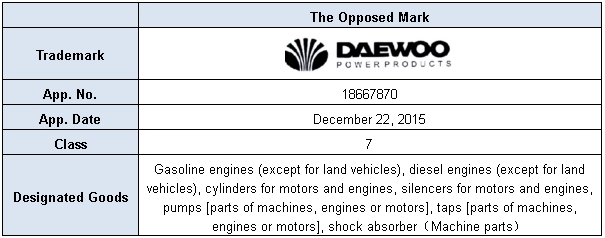Successful opposition to protect trademark right over non-similar but related goods
POSCO DAEWOO is a “Global Integrated Corporation”, mainly engaged in trading of a wide range of products for steel, automotive and its components, machinery and industrial electronics, non-ferrous metals, foods, chemicals, commodities and textiles, with both local and international customers. The company is engaged in moving beyond its existing traditional trading business and creating new businesses for the future. DAEWOO is continuously improving its brand value through wide promotion and use, and also by actively protecting its own trademark. DAEWOO’s core trademarks are  and
and .
.
In total, DAEWOO has applied for and/or registered around 3,500 trademarks in over 160 countries around the world. A global monitoring system helps in protecting its trademark rights; the trademarks are maintained and managed by applications and registrations across the world.
Background
The opponent found the opposing party rushed to register their image mark and the word mark over the relevant goods in bad faith. Kangxin Partners, P.C., acting on behalf of POSCO DAEWOO CORPORATION (“the opponent” hereunder), filed an opposition against the trademark  (No. 18667870) (“the opposed mark” hereunder) on May 15, 2017, and mainly argued that the application of opposed mark infringes on the prior trademark right of the opponent.
(No. 18667870) (“the opposed mark” hereunder) on May 15, 2017, and mainly argued that the application of opposed mark infringes on the prior trademark right of the opponent.
Below are details of the opposed mark:

Process
The opposed mark is obviously similar to the clients’ marks, but their goods are different according to the Chinese Classification of Goods and Services. The key issue before us is proving that the two types of goods have a high connection, so that the coexistence of the opposed mark and DAEWOO’s marks will cause confusion amongst the relevant consumers and market. To support the main claims, we filed an opposition and mainly argued that:
1. The opposed mark is “a similar mark”, compared to the cited marks. We compared the image and word portions of the mark separately with the cited marks, and pointed out the word portion of the opposed mark bears weak distinctiveness.
2. The goods classes in which the two marks were registered have a high connection. We argued the following aspects to support this claim: 1) the same category; we analyzed the products’ nature and function to prove that they should belong to the same category. 2) Closely operating principle; we referred to numerous academic articles discussing the goods relationship in operating and research, etc. to support this claim. 3) Sales overlap; to strengthen this argument, we collected evidence from online sales. 4) Similar intended use; 5) high connection in actual use; we referenced the products’ practical use along with the supporting evidence to reinforce this point.
3. The use and registration of the opposed mark will cause confusion and misunderstanding, so it will infringe on the opponent’s trademark right. We collected evidence to demonstrate the widespread use and promotion of the mark in mainland China, to prove the cited mark has obtained high reputation, and the opposed mark will cause confusion amongst the relevant public.
4. The opposing party filed the opposed mark with bad faith. To support this claim, we collected the trademark list that showed the opposing party filing a mark of another famous brand, thus violating the principle of good faith.
Conclusion
On April 29, 2018, the CTMO issued the decision, holding that the opposed mark was not approved for registration, reasoning that
1) The submitted evidence proved that the cited image mark and the word portion has originality and have obtained certain reputation amongst the relevant consumers.
2) The image and word portions of the opposed mark are similar to the cited marks separately, the two marks’ goods categories also having a high connection.
3) The facts of the case showed that the opposing party copied and imitated the trademark which has obtained a positive reputation, violating the principle of good faith and causing confusion and misunderstanding.
Thus, the opposed trademark was ruled to be rejected for registration.